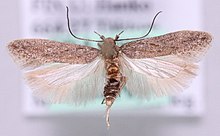| Scrobipalpa nitentella | |
|---|---|

| |
| Scientific classification | |
| Domain: | Eukaryota |
| Kingdom: | Animalia |
| Phylum: | Arthropoda |
| Class: | Insecta |
| Order: | Lepidoptera |
| Family: | Gelechiidae |
| Genus: | Scrobipalpa |
| Species: | S. nitentella |
| Binomial name | |
| Scrobipalpa nitentella (Fuchs, 1902) | |
| Synonyms | |
| |
Scrobipalpa nitentella, the common sea groundling, is a moth of the family Gelechiidae. It is found in most of Europe, North Africa (Tunisia), Turkey, Afghanistan, Kazakhstan, China (Qinghai, Xinjiang), Mongolia and Siberia (Transbaikalia).
The wingspan is 12–15 mm (0.47–0.59 in). A pale species difficult to very difficult to differentiate from other Scorobipalpa either from wing pattern or dissected genitalia.
Adults are on wing from July to August in one generation per year.
The larvae feed on Atriplex hastata, Atriplex hortensis, Atriplex littoralis, Atriplex praecox, Atriplex prostrate, Beta maritima, Chenopodium album, Halimione pedunculata, Halimione portulacoides, Salicornia europaea, Suaeda altissima and Suaeda maritima. Young larvae mine the leaves of their host plant. Full-grown larvae can be found from mid-August to the end of September.
References
- Fauna Europaea
- Bidzilya, O.; Li, H. 2010: The genus Scrobipalpa Janse (Lepidoptera, Gelechiidae) in China, with descriptions of 13 new species. Zootaxa, 2513: 1–26. Preview.
- Junnilainen, J. et al. 2010: The gelechiid fauna of the southern Ural Mountains, part II: list of recorded species with taxonomic notes (Lepidoptera: Gelechiidae). Zootaxa, 2367: 1–68. Preview
- Heath, J., ed. 1976 The Moths and Butterflies of Great Britain and Ireland Vol. 4 Part 2
- Langmaid, J. R., Palmer, S. M. & Young, M. R. . 2018 A Field Guide to the Smaller Moths of Great Britain and Ireland Reading, Berkshire. British Entomological and Natural History Society
- lepiforum.de includes images
 This article incorporates text from this source, which is in the public domain.
This article incorporates text from this source, which is in the public domain.
- UKmoths
- bladmineerders.nl
| Taxon identifiers | |
|---|---|
| Scrobipalpa nitentella |
|
This article on a moth of the genus Scrobipalpa is a stub. You can help Misplaced Pages by expanding it. |